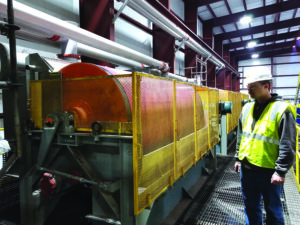
The hybrid unit has been designed as a drop-in replacement for the traditional wet drum separator (above).
A new hybrid magnetic separator could improve recovery for heavy-media plants
By Steve Fiscor, Editor-in-Chief
Eriez has been busy applying innovations in both magnetic circuit design and materials of construction to its line of wet drum magnetic separators. The goal is to maximize magnetite recovery while operating with a minimum amount of wear and maintenance.
One of its newest developments is the Hybrid Wet Drum Separator, which is expected to enhance magnetic recovery in heavy media circuits. The hybrid element uses ceramic material and rare earth magnets to deliver 60% higher gauss in the separating zone when compared to the industry standard 950 gauss interpole magnetic circuit.
The traditional wet drum separators in use at most heavy-media coal prep plants use a low intensity magnetic field and they work well. Magnetite is expensive, however, and an any improvement in recovery will likely pay for itself quickly over time. “The existing systems perform well as long as they are operated properly,” said Jose Marin, director, minerals and materials processing for Eriez. “However, we believe these hybrid systems could achieve nearly 100% recovery.”
The Eriez Hybrid Wet Drum Separator was originally developed for use in the iron ore industry. “Field results in iron ore concentration has proven the superiority of these state-of-the-art separators,” Marin said. “In fact, the increased recovery of magnetite in the rougher stage at an iron ore concentrator prompted the replacement of more than 20 48-in. diameter rougher units.”
The Hybrid Wet Drum Separator was constructed with a high intensity section that uses rare earth magnets followed by lower-magnetic transition preceding the ceramic section that discharges the magnetite. The rare earth magnets, Marin explained, attract magnetite with so much force that, without the transition into a lower intensity magnetic section, the magnetite would never discharge.
“The use of ceramics and rare earth magnets is why we refer to it as a hybrid system,” Marin said. “We have placed several units into the iron ore side of the mining business and those miners have reported great results.” The hybrid units are obviously more expensive, but Marin believes the payback would be quick and Eriez has been looking to place units in coal preparation plants to see how well it will perform in a coal application.
Designed as a Replacement Unit
Eriez has designed the Hybrid Wet Drum Separator as a replacement unit for a traditional wet drum separator. The hybrid drum, coupled with the self-leveling tank, maintains the current layout of a standard wet drum and is identical to the widely used 950-gauss wet drum separator, making the upgrade of existing 36- and 48-in. diameter wet drums to the Hybrid Wet Drum Separator easy. The 950 interpole wet drum can be retrofitted without altering the existing tank or drive.
According to Eriez, approximately two-thirds of the magnetic element in Hybrid Wet Drum Separator is constructed with rare earth magnets. The remainder consists of a transition section onto a ceramic element. This advanced design allows these stronger drums to properly discharge magnetite without flow interference. Furthermore, the high-capacity design accommodates surges and fluctuations in the feed rate.
Improving magnetite recovery would have a positive impact on operational costs. “If a plant is losing magnetite, even if the losses are within the industry standards, the mining company still has to replenish that magnetite supply,” Marin said.
“The typical recovery of magnetite in a heavy media plant using traditional technology can be as high as 99%, while the anticipated recovery using a Hybrid Wet Drum Separator is close to 99.99%,” Marin said. “If we could move the needle closer to a 100% recovery, it would lower operational costs and increase profitability.”
Maintenance is Key
Eriez supplied most of the wet-drum magnetic separators that are in use in the coal industry today. “Over the years, a number of prep plants have been idled and coal companies are refurbishing equipment rather than buying new equipment, and that’s understandable,” Marin said. “It’s important to make sure that equipment is operating correctly. Visual inspection and sampling are still the best way to verify performance.”
Wet-drum separators are manufactured in a way that requires minimal maintenance. “There are certain areas in the country where the slurry that is generated in a coal preparation plant tends to be very corrosive,” Marin said. “In those cases, we would recommend using stainless steel construction throughout on the drums.”
As with all equipment, lubrication is very important. It’s also important to identify the signs that the bearings are starting to wear.
Eriez believes that, with proper care and maintenance, prep plants should expect to get 10 to 12 years of operation from these units.




